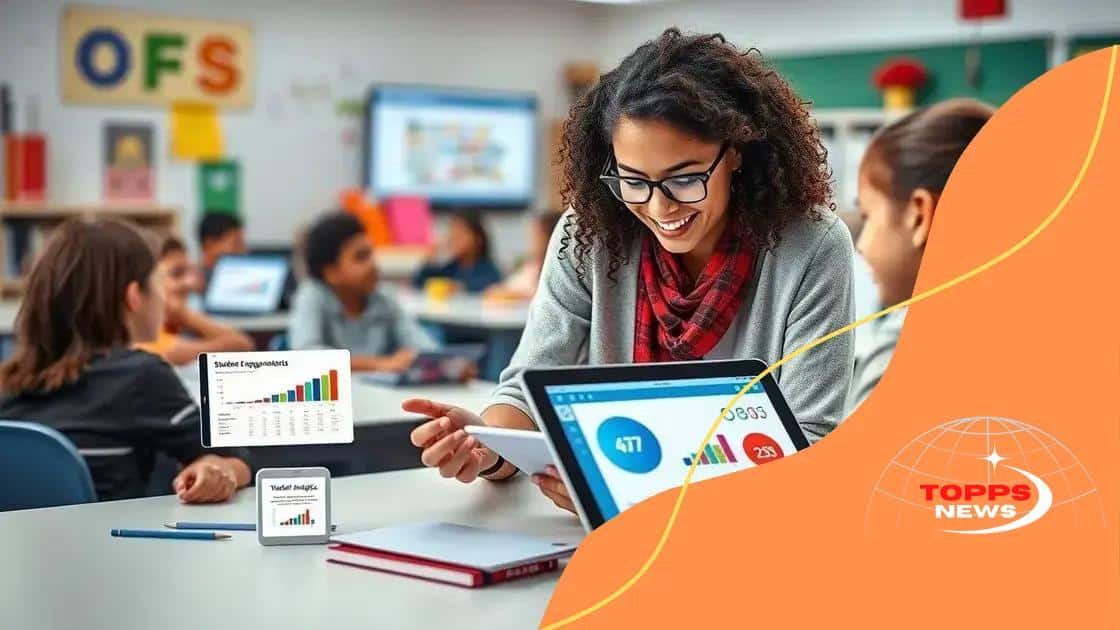AI for student engagement tracking: revolutionizing learning

AI for student engagement tracking enhances learning by personalizing educational experiences and providing real-time insights into student participation, improving outcomes and classroom management.
AI for student engagement tracking is changing how educators connect with students. Imagine having tools that gauge participation and help tailor learning experiences. Curious about how this technology can empower your teaching methods? Let’s dive in!
Understanding student engagement tracking
Understanding student engagement tracking is essential for modern education. It helps teachers identify how actively students are participating in their learning. With various tools available today, educators can monitor engagement in real-time, making lessons more relevant.
The Importance of Tracking Engagement
When teachers know how engaged students are, they can adjust their instructional strategies. For instance, students who participate more are likely to retain information better. Therefore, tracking tools can play a crucial role in adapting curriculum to meet student needs.
- Enhances learning outcomes
- Informs teaching methods
- Encourages student accountability
- Identifies at-risk students
Another aspect of student engagement tracking is its ability to foster a sense of belonging. When teachers notice that a student is less engaged, they can reach out to understand their challenges. This approach helps build positive relationships, which are vital for student success.
Methods of Engagement Tracking
There are several methods to track student engagement effectively. Teachers might use surveys or feedback forms to gather information. Other innovative tools involve data analytics and real-time polling during lessons, making it easier to engage students dynamically.
- Online learning platforms
- Interactive quizzes
- Behavior tracking systems
Utilizing technology in tracking can lead to better engagement metrics. These insights provide valuable data that can refine instructional strategies, ultimately benefiting all students. With robust tracking, teachers can ensure that no child falls behind.
The role of AI in monitoring participation
The role of AI in monitoring participation is transforming the landscape of education. With the advancement of technology, teachers can now access powerful tools that analyze student involvement in real-time. This capability enables educators to adapt their strategies to promote a more interactive and engaging learning environment.
How AI Works in the Classroom
AI technologies utilize data collection methods to track various metrics related to student participation. For example, participation levels can be gauged through online discussions, quizzes, and attendance records. This data provides educators with insights into how students are engaging with the material.
- Real-time analytics
- Identifying participation trends
- Customized learning experiences
Moreover, AI can flag students who may be struggling or lacking participation. This proactive approach allows teachers to intervene early, providing support to those who need it the most. By leveraging AI, educational institutions create a more personalized learning experience.
Benefits of AI in Monitoring
There are numerous benefits to using AI in the classroom. For instance, AI tools can streamline administrative tasks, allowing educators to spend more time teaching. Additionally, these technologies foster a data-driven approach to education. This means decisions made by schools are based on accurate, real-time data rather than assumptions.
- Improved student outcomes
- Enhanced engagement metrics
- Facilitated teacher insights
Using AI not only improves the learning experience but also empowers educators with the information they need to make informed decisions. As schools continue to embrace technology, the role of AI in monitoring will grow, paving the way for innovative teaching methods.
Tools and technologies for tracking engagement

Tools and technologies for tracking engagement are vital in today’s educational landscape. They offer teachers the ability to monitor student participation effectively. With a variety of options available, educators can choose the tools that best suit their classroom needs.
Types of Engagement Tracking Tools
There are several types of tools that educators can use. These tools vary in functionality and can provide different insights into student engagement. Some popular tools include:
- Learning Management Systems (LMS)
- Survey and feedback platforms
- Real-time polling applications
- Analytics software
Each of these tools has unique features. For example, LMS platforms often include analytics dashboards that show attendance and participation rates. On the other hand, polling applications help gauge student understanding during lessons, making them interactive.
Benefits of Using Technology
Integrating technology for engagement tracking has numerous benefits. It not only simplifies data collection but also enables more informed decision-making. Teachers can adjust their instructional methods based on real-time data. This leads to more personalized learning experiences for students.
- Increased insights into student behavior
- Enhanced ability to identify struggling students
- Streamlined communication with students and parents
Furthermore, these tools promote a deeper understanding of student dynamics. By utilizing technology, educators can foster an environment where students feel more connected and engaged. This approach is essential for building a strong classroom community.
Data analysis and its impact on learning outcomes
Data analysis plays a crucial role in understanding learning outcomes. By examining student performance data, educators can identify trends and areas that need improvement. This analytical approach allows for tailored teaching strategies that address specific student needs.
The Importance of Data in Education
The use of data analysis in education helps create a more informed learning environment. Educators can track various factors, such as test scores and attendance. Understanding these elements provides insight into what methods work best for different learners. When teachers have access to accurate data, they are better equipped to enhance educational experiences.
- Identifying at-risk students
- Measuring the effectiveness of teaching strategies
- Improving curriculum planning
- Fostering a data-driven culture
Employing data-driven decisions can lead to improved learning outcomes. By analyzing performance metrics, teachers can pinpoint which students may need additional support. This approach encourages early intervention, ensuring that no student falls behind. Educators can adapt their teaching methods based on real-time feedback and outcomes.
Impact of Data Analysis on Student Success
Data analysis not only enhances individual student performance but also improves overall classroom dynamics. When teachers utilize data to inform their practices, they create a more engaging learning environment. This engagement boosts motivation and participation among students.
- Encouraging personalized learning paths
- Enhancing collaboration among educators
- Facilitating targeted tutoring
Ultimately, the impact of data analysis on learning outcomes is profound. Schools that embrace these methods tend to see higher student achievement and satisfaction rates. Through robust data analytics, teachers can ensure that their instruction is equitable and effective for all learners.
Future trends in AI for education
Future trends in AI for education are shaping how students learn and teachers teach. As technology evolves, the ways in which AI supports educational experiences are becoming more sophisticated. These advancements promise to create personalized learning paths that cater to each student’s unique needs.
The Rise of Personalized Learning
One significant trend is the move towards personalized learning. AI technologies can analyze individual student data to tailor educational content. This means that each student can have a unique learning experience suited just for them. With AI, teachers can provide specific resources that match the student’s learning style, thereby improving engagement and understanding.
- Adaptive learning platforms
- Customized lesson plans
- Real-time feedback systems
Moreover, AI can help identify learning gaps more effectively. For instance, if a student struggles with a particular topic, AI can suggest targeted exercises or additional resources to address these weaknesses. This proactive approach can significantly enhance learning outcomes.
AI and Enhanced Classroom Management
Another trend is the use of AI for enhanced classroom management. Tools that analyze student behavior and engagement can help teachers maintain a positive learning environment. With data-driven insights, teachers can make informed decisions about group dynamics and classroom activities.
- Behavioral analytics
- Attendance tracking systems
- Engagement monitoring tools
These technologies not only help teachers manage their classrooms but also foster student accountability. With clear feedback, students are more aware of their progress, motivating them to engage more deeply with their education. As AI continues to improve, we can expect even more innovative applications in educational settings.
FAQ – Frequently Asked Questions about AI in Education
How does AI personalize student learning?
AI analyzes individual student data to tailor educational content and resources, ensuring that each student receives a unique learning experience.
What tools can be used for monitoring student engagement?
Tools like Learning Management Systems (LMS), real-time polling apps, and analytics software help track student participation and provide valuable insights.
How can data analysis impact learning outcomes?
Data analysis allows teachers to identify learning gaps and adjust their teaching strategies, leading to improved student performance and engagement.
What are the future trends for AI in education?
Future trends include increased personalized learning, enhanced classroom management tools, and greater use of data-driven insights to improve educational practices.





